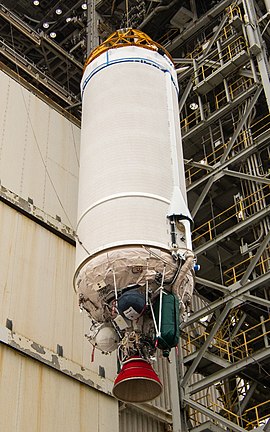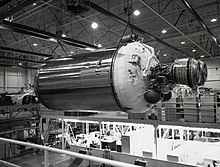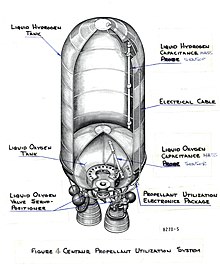
Back Центавър (ускорителен блок) Bulgarian Centaur (tram de coet) Catalan Centaur (raketový stupeň) Czech Centaur (Raketenoberstufe) German Centauro (cohete) Spanish Centaur (rakettivaihe) Finnish Centaur (étage de fusée) French Centaur (foguetes) Galician קנטאור (שלב משגר) HE Centaur (raketa) Croatian
 A single-engine Centaur III being raised for mating to an Atlas V rocket | |
| Manufacturer | United Launch Alliance |
|---|---|
| Used on |
|
| General characteristics | |
| Height | 12.68 m (499 in)[1] |
| Diameter | 3.05 m (120 in) |
| Propellant mass | 20,830 kg (45,920 lb) |
| Empty mass | 2,247 kg (4,954 lb), single engine 2,462 kg (5,428 lb), dual engine |
| Centaur III | |
| Powered by | 1 or 2 RL10 |
| Maximum thrust | 99.2 kN (22,300 lbf), per engine |
| Specific impulse | 450.5 seconds (4.418 km/s) |
| Burn time | Variable |
| Propellant | LH2 / LOX |
| Associated stages | |
| Derivatives | Centaur V Advanced Cryogenic Evolved Stage |
| Launch history | |
| Status | Active |
| Total launches | 271 as of January 2024[update][2] |
| First flight | May 9, 1962 |



The Centaur is a family of rocket propelled upper stages that has been in use since 1962. It is currently produced by U.S. launch service provider United Launch Alliance, with one main active version and one version under development. The 3.05 m (10.0 ft) diameter Common Centaur/Centaur III flies as the upper stage of the Atlas V launch vehicle, and the 5.4 m (18 ft) diameter Centaur V has been developed as the upper stage of ULA's new Vulcan rocket.[4][5] Centaur was the first rocket stage to use liquid hydrogen (LH2) and liquid oxygen (LOX) propellants, a high-energy combination that is ideal for upper stages but has significant handling difficulties.[6]
- ^ "Altas V Launch Services User's Guide" (PDF). United Launch Alliance. March 2010. Archived from the original (PDF) on March 6, 2012. Retrieved July 9, 2015.
- ^ Cite error: The named reference
GSPCentaurwas invoked but never defined (see the help page). - ^ NASA (n.d.). "SPC Centaur Testing". Retrieved February 12, 2012.
- ^ Berger, Eric (December 11, 2018). "Getting Vulcan up to speed: Part one of our interview with Tory Bruno". Ars Technica. Retrieved December 12, 2018.
Centaur 3 (which flies on the Atlas V rocket) is 3.8 meters in diameter. The very first Centaur we fly on Vulcan will go straight to 5.4 meters in diameter.
- ^ "Vulcan Centaur". United Launch Alliance. 2018. Retrieved December 12, 2018.
- ^ Helen T. Wells; Susan H. Whiteley; Carrie E. Karegeannes. "Launch Vehicles". Origin of NASA Names. NASA Science and Technical Information Office. p. 11. Archived from the original on July 14, 2019. Retrieved March 29, 2019.
because it proposed to make first use of the theoretically powerful but problem-making liquid hydrogen as fuel.
© MMXXIII Rich X Search. We shall prevail. All rights reserved. Rich X Search